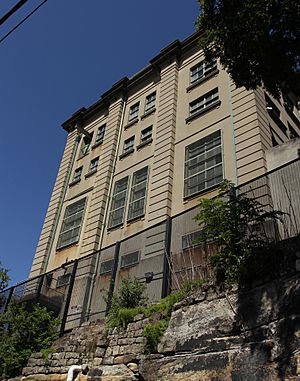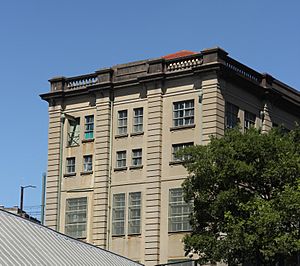Argyle Street Railway Substation facts for kids
The Argyle Street Railway Substation is a special building in Millers Point, Sydney. It helps power the electric trains and the Sydney Harbour Bridge. Built in 1932 by Dorman, Long and Co., it's also known as the Sydney Harbour Bridge Substation. This important building is protected as a heritage site. It's owned by RailCorp, which is part of the Government of New South Wales.
Quick facts for kids Argyle Street Railway Substation |
|
|---|---|

Argyle Street Railway Substation, pictured from Trinity Avenue, Millers Point, in 2019.
|
|
| Location | Trinity Avenue, Millers Point, City of Sydney, New South Wales, Australia |
| Built | 1932 |
| Built for | New South Wales Government Railways |
| Architectural style(s) | Inter-War Stripped Classical |
| Owner | RailCorp |
| Official name: Argyle Street Railway Substation; Sydney Harbour Bridge Substation | |
| Type | State heritage (built) |
| Designated | 2 April 1999 |
| Reference no. | 1022 |
| Type | Electricity Transformer/Substation |
| Category | Utilities - Electricity |
| Builders | Dorman, Long and Co. |
| Lua error in Module:Location_map at line 420: attempt to index field 'wikibase' (a nil value). | |
Contents
A Powerhouse for Trains and the Bridge
The Argyle Substation was built at the same time as the Sydney Harbour Bridge. It was a key part of making Sydney's railway system electric. The building's design matches the style of the bridge's entrance. It was finished in 1932.
This substation was one of 15 built between 1926 and 1932. These buildings helped change the suburban trains from steam to electric power. Each substation had a similar design. However, the Argyle Street one was covered in a special cement finish. This made it look like the Sydney Harbour Bridge.
Substations are needed because electric trains use direct current (DC) power. The power from big stations like Ultimo Power Station and White Bay Power Station is alternating current (AC). The substation changes this AC power into 1500 volts DC. This DC power then goes to the overhead wires that power the trains. It also powered the original lights on the Sydney Harbour Bridge.
Over the years, some parts of the substation have been updated. For example, the original switches were changed before World War II. Later, bigger transformers were installed. These transformers were updated again around 1999-2000 to handle more electricity. One old switch is still kept inside, but it doesn't work anymore.
The Sydney Harbour Bridge was a huge project. It was planned by J. J. C. Bradfield to connect the city with the north shore. This made it easier for people to travel. Building the bridge meant a lot of construction work. Some streets in Dawes Point and The Rocks area were changed. The bridge's entrance areas were designed and built between 1924 and 1932.
What the Substation Looks Like
The Argyle Street Substation is located on a hill above Trinity Avenue. It's surrounded by a steel fence. The site includes the main substation building, a smaller switchhouse, and outdoor electrical equipment.
The Main Building (1932)
The main substation building is four storeys tall. It's made of brick and covered in a smooth finish. Its style is called Inter-War Stripped Classical. It has steel windows and decorative columns. You can enter it from the Harbour Bridge cycleway through wooden doors. The building also has a special roof with two levels.
Inside, the roof is held up by steel beams. The two lower floors hold the working electrical equipment. The upper floors have control rooms, offices, and staff areas. Large roller doors on the ground floor allow big equipment to be moved in and out. Steel stairs connect the different levels.
The Switchhouse (1932)
South of the main building is the switchhouse. It's a single-storey building with steel-framed windows. It has a tiled roof that slopes on all sides.
The roof inside is supported by steel beams. The floor is concrete, and the walls are painted brick. The switchhouse still has one old Reyrolle Oil Bath Motorised Switch. It doesn't work anymore. There are also modern switchboards here.
The Yard
Outside, between the main building and the switchhouse, are the large transformers. These are important for changing the electricity.
Special Items Inside
Some old items are still kept inside the buildings. These include the Reyrolle Motorised Switch in the switchhouse. In the main substation, there's an old wooden phone box, a switchboard, a framed map of the Sydney Harbour Bridge, and a large overhead crane.
Changes Over Time
- After 1962 (exact date unknown): The transformers were upgraded.
- 1999-2000: The transformers were upgraded again to handle more power.
Why It's a Heritage Site
The Argyle Street Substation is very important to the history of New South Wales. It's a unique part of how the Sydney Harbour Bridge was built. It was one of 15 substations built to electrify Sydney's trains. It still helps convert electricity for the train network today.
The building is a great example of the Inter-War Stripped Classical style. It stands out as an important industrial building in Millers Point. Its plain, cement finish matches the look of the Sydney Harbour Bridge's entrance. The substation also has a rare example of its original switchgear inside.
The Argyle Street Railway Substation was added to the New South Wales State Heritage Register on April 2, 1999. This means it's officially recognized for its importance.
- It shows how history unfolded in New South Wales.
The substation was a key part of the Sydney Harbour Bridge project. It helped electrify Sydney's train system. It played a big role in providing electricity for the new rail network across the bridge. This helped connect Sydney's north shore to the city, changing how people lived and traveled.
- It shows great design and technical skill.
The substation building is a well-preserved example of an Inter-War Stripped Classical industrial building. It's a noticeable feature near the Sydney Harbour Bridge. Its matching design helps it blend with the bridge's entrance. Its location highlights its important job for the bridge and railway. It's a landmark in the Millers Point area.
- It has a special meaning for the community.
This place helps people feel connected to their local history. It's a part of the community's story.
- It has rare or unique features.
The Argyle Street substation is a unique part of the Sydney Harbour Bridge's infrastructure. Out of the fifteen substations built, it's the only one with this specific design and finish. This was done to match the Sydney Harbour Bridge. The Reyrolle Oil Bath Motorised Switches are also a rare example of an old type of switch.
- It shows typical features of its kind.
The Argyle Street substation is a good example of the Inter-War Stripped Classical style used in industrial buildings. It also shows the standard design used for NSW Railways substations built between 1926 and 1932.


